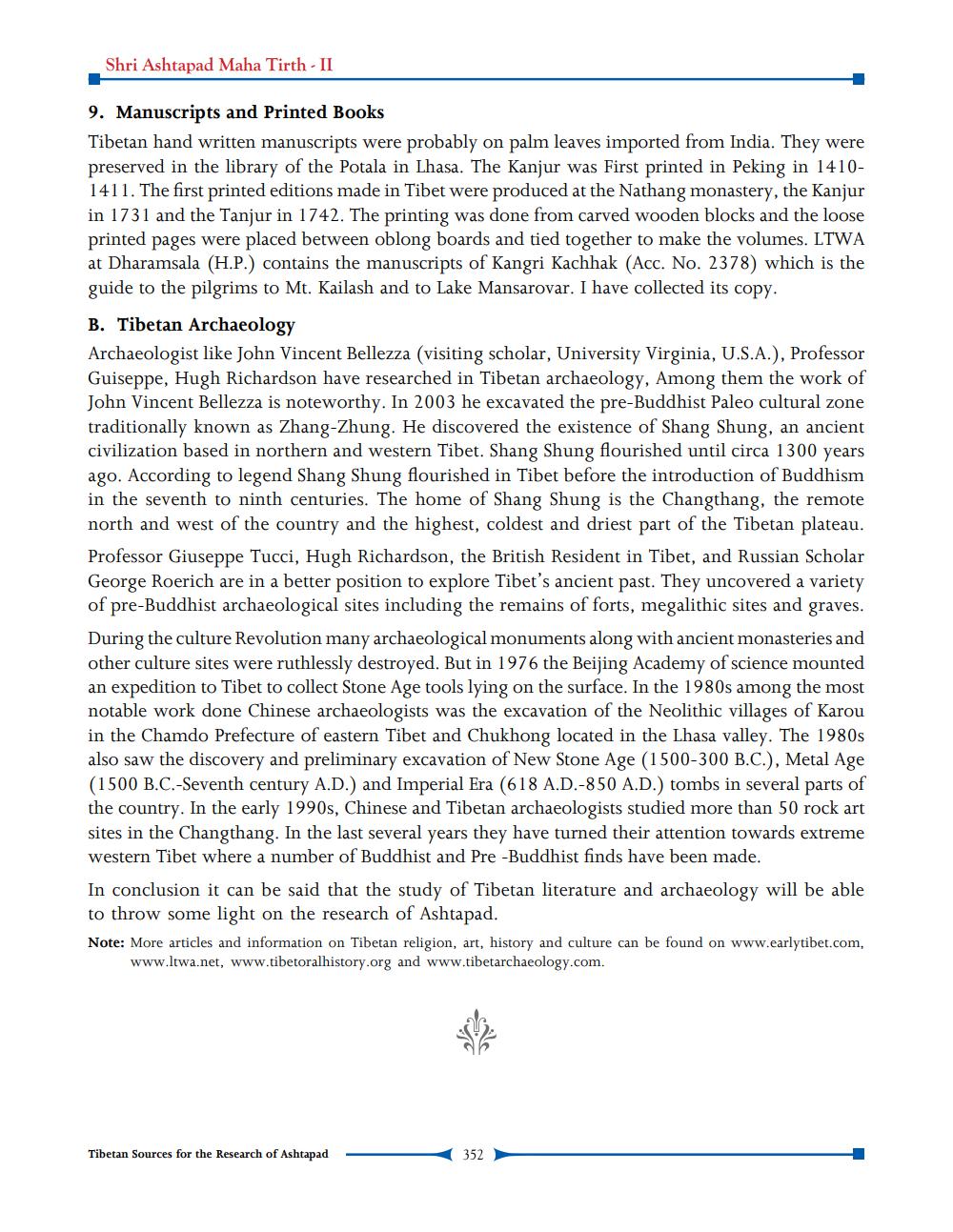________________
Shri Ashtapad Maha Tirth - II
9. Manuscripts and Printed Books Tibetan hand written manuscripts were probably on palm leaves imported from India. They were preserved in the library of the Potala in Lhasa. The Kanjur was first printed in Peking in 14101411. The first printed editions made in Tibet were produced at the Nathang monastery, the Kanjur in 1731 and the Tanjur in 1742. The printing was done from carved wooden blocks and the loose printed pages were placed between oblong boards and tied together to make the volumes. LTWA at Dharamsala (H.P.) contains the manuscripts of Kangri Kachhak (Acc. No. 2378) which is the guide to the pilgrims to Mt. Kailash and to Lake Mansarovar. I have collected its copy.
B. Tibetan Archaeology Archaeologist like John Vincent Bellezza (visiting scholar, University Virginia, U.S.A.), Professor Guiseppe, Hugh Richardson have researched in Tibetan archaeology, Among them the work of John Vincent Bellezza is noteworthy. In 2003 he excavated the pre-Buddhist Paleo cultural zone traditionally known as Zhang-Zhung. He discovered the existence of Shang Shung, an ancient civilization based in northern and western Tibet. Shang Shung flourished until circa 1300 years ago. According to legend Shang Shung flourished in Tibet before the introduction of Buddhism in the seventh to ninth centuries. The home of Shang Shung is the Changthang, the remote north and west of the country and the highest, coldest and driest part of the Tibetan plateau. Professor Giuseppe Tucci, Hugh Richardson, the British Resident in Tibet, and Russian Scholar George Roerich are in a better position to explore Tibet's ancient past. They uncovered a variety of pre-Buddhist archaeological sites including the remains of forts, megalithic sites and graves. During the culture Revolution many archaeological monuments along with ancient monasteries and other culture sites were ruthlessly destroyed. But in 1976 the Beijing Academy of science mounted an expedition to Tibet to collect Stone Age tools lying on the surface. In the 1980s among the most notable work done Chinese archaeologists was the excavation of the Neolithic villages of Karou in the Chamdo Prefecture of eastern Tibet and Chukhong located in the Lhasa valley. The 1980s also saw the discovery and preliminary excavation of New Stone Age (1500-300 B.C.), Metal Age (1500 B.C.-Seventh century A.D.) and Imperial Era (618 A.D.-850 A.D.) tombs in several parts of the country. In the early 1990s, Chinese and Tibetan archaeologists studied more than 50 rock art sites in the Changthang. In the last several years they have turned their attention towards extreme western Tibet where a number of Buddhist and Pre-Buddhist finds have been made. In conclusion it can be said that the study of Tibetan literature and archaeology will be able to throw some light on the research of Ashtapad. Note: More articles and information on Tibetan religion, art, history and culture can be found on www.earlytibet.com,
www.ltwa.net, www.tibetoralhistory.org and www.tibetarchaeology.com.
Tibetan Sources for the Research of Ashtapad
352




